
The Curtiss P-40 Warhawk is an American single-engined, single-seat, all-metal fighter and ground-attack aircraft that first flew in 1938. The P-40 design was a modification of the previous Curtiss P-36 Hawk which reduced development time and enabled a rapid entry into production and operational service. The Warhawk was used by most Allied powers during World War II, and remained in frontline service until the end of the war. It was the third most-produced American fighter of World War II, after the P-51 and P-47; by November 1944, when production of the P-40 ceased, 13,738 had been built, all at Curtiss-Wright Corporation's main production facilities in Buffalo, New York.

The Republic P-47 Thunderbolt is a World War II-era fighter aircraft produced by the American company Republic Aviation from 1941 through 1945. It was a successful high-altitude fighter and it also served as the foremost American fighter-bomber in the ground-attack role. Its primary armament was eight .50-caliber machine guns, and it could carry 5-inch rockets or a bomb load of 2,500 lb (1,100 kg). When fully loaded, the P-47 weighed up to 8 tons, making it one of the heaviest fighters of the war.

Francis Stanley "Gabby" Gabreski was a polish career pilot in the United States Air Force who retired as a colonel after 26 years of military service. He was the top American and United States Army Air Forces fighter ace over Europe during World War II and a jet fighter ace with the Air Force in the Korean War.

Fighter Squadron is a 1948 American World War II aviation war film in Technicolor from Warner Bros., produced by Seton I. Miller, directed by Raoul Walsh, that stars Edmond O'Brien, Robert Stack, and John Rodney.

Thunderbolt is a 1947 film directed by William Wyler and John Sturges which documented the American aerial operations of Operation Strangle in World War II, when flyers of the Twelfth Air Force based on Corsica successfully impeded Axis supply lines to the Gustav Line and Anzio beachhead. The film was originally shot in 16mm color by members of the Army Air Forces. The 12th Combat Camera Unit recorded the combat footage using cameras mounted on some of the P-47s and a B-25 medium bomber equipped as a camera ship to accompany the fighters.

Charles Joseph Loring Jr. was a fighter pilot in the United States Army Air Forces in World War II, and later in the United States Air Force in the Korean War. Loring rose to the rank of major and posthumously received the Medal of Honor for his heroic actions on November 22, 1952, above Kunwha, Korea during a close air support mission.

Frederick Joseph Christensen Jr. was an American fighter pilot and flying ace who flew with the United States Army Air Forces during World War II. A member of the 56th Fighter Group in England, Christensen scored 21½ aerial victories. He later served 24 years as a command officer with both the Air National Guard and the Air Force Reserve, retiring as a lieutenant colonel.

The 25th Fighter Squadron is part of the US Air Force's 51st Operations Group, 51st Fighter Wing, at Osan Air Base, South Korea. It operates the Fairchild Republic A-10 Thunderbolt II aircraft conducting close air support missions.

The 63d Fighter Squadron is an active United States Air Force unit, assigned to the 56th Operations Group, at Luke Air Force Base, Arizona. It operates the F-35A aircraft, and conducts advanced fighter training since its reactivation in 2016. When this Squadron was reactivated in 1975, their mission was to train pilots and weapons systems officers for the McDonnell F-4E Phantom II, and they switched to the F-4D in 1978.

The 108th Operations Group is a unit of the 108th Wing of the New Jersey Air National Guard, one of the many units stationed at the McGuire AFB entity of Joint Base McGuire-Dix-Lakehurst, New Jersey. If activated to federal service with the U.S. Air Force, the group is gained by Air Mobility Command (AMC).

The 90th Flying Training Squadron is part of the 80th Flying Training Wing based at Sheppard Air Force Base, Texas. It operates Northrop T-38 Talon aircraft conducting flight training.

The 99th Flying Training Squadron flies Raytheon T-1 Jayhawks and they have painted the tails of their aircraft red in honor of the Tuskegee Airmen of World War II fame, known as the "Red Tails," whose lineage the 99 FTS inherited.

The 56th Operations Group is a unit of the United States Air Force, and the flying component of the 56th Fighter Wing.
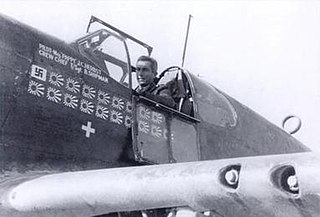
John C. "Pappy" Herbst was an American flying ace of World War II who was officially the second highest-scoring fighter pilot in the China Burma India Theater with 18 confirmed victories scored during 7 months with the 23d Fighter Group. The group commander, David Lee "Tex" Hill, called Herbst "one of the greatest fighter pilots I ever saw."
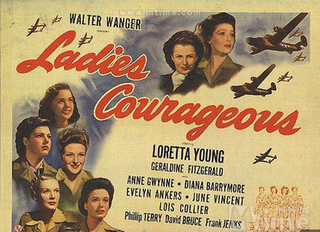
Ladies Courageous is a 1944 war film based on the novel Looking For Trouble (1941) by Virginia Spencer Cowles. Directed by John Rawlins, the film stars Loretta Young and Geraldine Fitzgerald. It tells the story of the paramilitary Women's Auxiliary Ferrying Squadron formed in the United States during World War II. Film historians and scholars consider Ladies Courageous an à-clef story of famed aviator Jacqueline Cochran and test pilot Nancy Harkness Love's work to mobilize women pilots to contribute to the war effort.
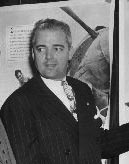
Herbert O. Fisher was an American test pilot and an aviation executive, overseeing aviation projects at the Port Authority of New York and New Jersey. He worked for the Curtiss-Wright Corporation. Fisher flew as a pilot for over 50 years, racking up 19,351 accident and violation free hours.

Gerald Richard Johnson was a World War II flying ace who flew for the United States Army Air Forces. Johnson commanded the 9th Fighter Squadron and 49th Fighter Group, and became the fourth ranking fighter ace in the Pacific during World War II. He ended his war career with 22 kills.
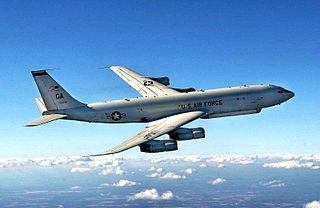
The 116th Operations Group is a Georgia Air National Guard unit assigned to the 116th Air Control Wing. The unit is stationed at Robins Air Force Base, Georgia. The 116th Group controls all operational Northrop Grumman E-8C Joint STARS aircraft of the 116th Air Control Wing. It was activated in 1992, when the Air Force implemented the Objective Wing organization, and was successively equipped with the McDonnell Douglas F-15 Eagle and the Rockwell B-1 Lancer before converting to the E-8C in 2002.
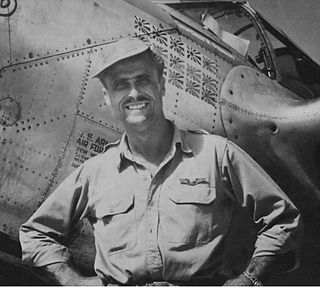
Robert Burdette Westbrook was a United States Army Air Forces lieutenant colonel and a World War II flying ace. Westbrook commanded the 44th Fighter Squadron, and became the leading fighter ace of the Thirteenth Air Force. He is also the ninth ranking fighter ace in the Pacific during World War II and also one of ten United States Army Air Forces pilots who became an ace in two different types of fighter aircraft.

James H. Harvey III is a retired United States Army Air Corps/U.S. Air Force (USAF) officer and former African-American fighter pilot with the 332nd Fighter Group's 99th Fighter Squadron, best known as the Tuskegee Airmen, "Red Tails," or among enemy German pilots, Schwartze Vogelmenschen. He is one of the 1007 documented Tuskegee Airmen Pilots.




















